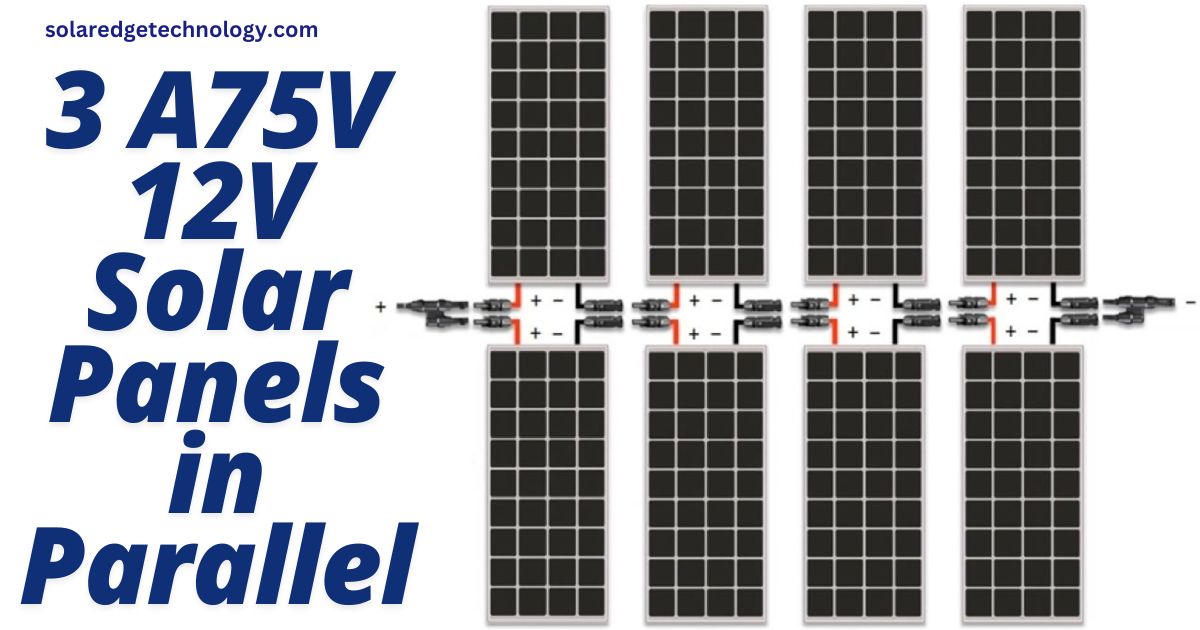Solar energy systems have revolutionized the way we harness and utilize renewable energy. When it comes to optimizing solar power for your needs, understanding how to set up solar panels effectively is crucial. In this article, we’ll explore the setup of three A75V 12V solar panels in parallel, its advantages, and considerations to ensure optimal performance.
What Does It Mean to Connect Solar Panels in Parallel?
Connecting solar panels in parallel involves wiring multiple panels so that their positive terminals are connected together, and their negative terminals are similarly linked. This setup maintains the voltage of a single panel while combining the total current output of all panels. For three A75V 12V solar panels:
- Voltage remains constant at 12V.
- Current adds up, increasing the total output.
Benefits of Parallel Connection
1. Increased Current Output
When solar panels are connected in parallel, their individual currents combine. For instance, if each A75V 12V panel produces 5 amps, the total output in a parallel configuration would be 15 amps, while the voltage remains steady at 12V.
2. Improved Efficiency in Shaded Areas
Parallel connections allow the system to perform better when one or more panels are shaded. Unlike series connections, where shading on one panel can reduce the output of the entire array, parallel connections isolate the impact, ensuring continued energy generation.
3. Flexibility in System Design
A parallel configuration is ideal for applications requiring a stable voltage. It’s compatible with many 12V battery systems, making it suitable for RVs, boats, and off-grid setups.
How to Connect 3 A75V 12V Solar Panels in Parallel
Materials Needed:
- Three A75V 12V solar panels
- Parallel connectors (branch connectors or a combiner box)
- Solar charge controller compatible with the total current
- Properly rated cables and fuses
Step-by-Step Guide:
- Safety First: Always ensure the panels are disconnected from any load before starting.
- Position the Panels: Place the solar panels in a location with maximum sun exposure, ensuring they are angled correctly for optimal efficiency.
- Connect the Terminals: Use branch connectors or a combiner box to link all the positive terminals of the panels together. Repeat the process for the negative terminals.
- Attach to the Charge Controller: Connect the combined positive output to the charge controller’s input, followed by the combined negative output.
- Test the System: Check the voltage and current output using a multimeter to ensure everything is functioning as expected.
Considerations for Optimal Performance
1. Use a Compatible Charge Controller
Since the current output increases in parallel configurations, ensure your solar charge controller can handle the combined amperage. A controller with Maximum Power Point Tracking (MPPT) technology is ideal for maximizing efficiency.
2. Cable Sizing
Use appropriately rated cables to handle the increased current. Undersized cables can cause overheating and energy loss.
3. Fuse Protection
Install fuses between each panel and the combiner box to protect the system from potential faults or overloads.
4. Monitor Shading
Although parallel setups are more tolerant of shading, it’s best to position the panels in an area with minimal obstructions to sunlight.
Applications for a Parallel Setup with A75V 12V Solar Panels
– Off-Grid Power Systems
Perfect for remote cabins, camping setups, and backup power solutions.
– Recreational Vehicles (RVs)
Ensures a steady 12V supply for batteries and appliances.
– Marine Applications
Provides reliable power for boats and yachts, maintaining battery charge for navigation and onboard systems.
Conclusion
Connecting 3 A75V 12V solar panels in parallel is an efficient way to increase your system’s current output while maintaining a stable voltage. This setup is ideal for various applications, including off-grid and mobile power solutions. By following proper installation guidelines and considering factors like cable sizing, charge controllers, and shading, you can harness solar energy effectively and sustainably.
Harness the power of the sun with confidence and enjoy the benefits of renewable energy tailored to your needs!
